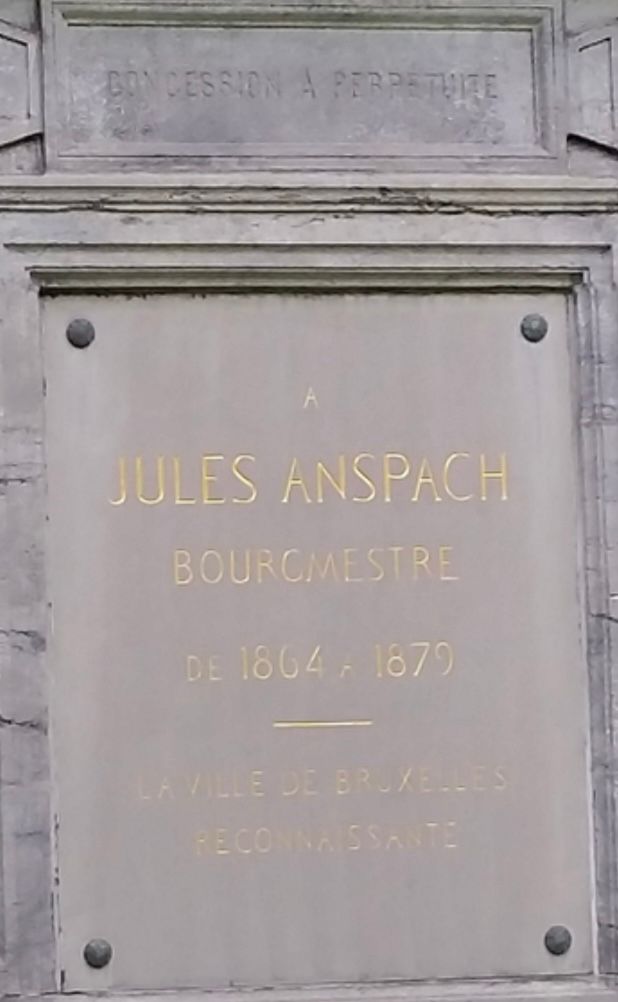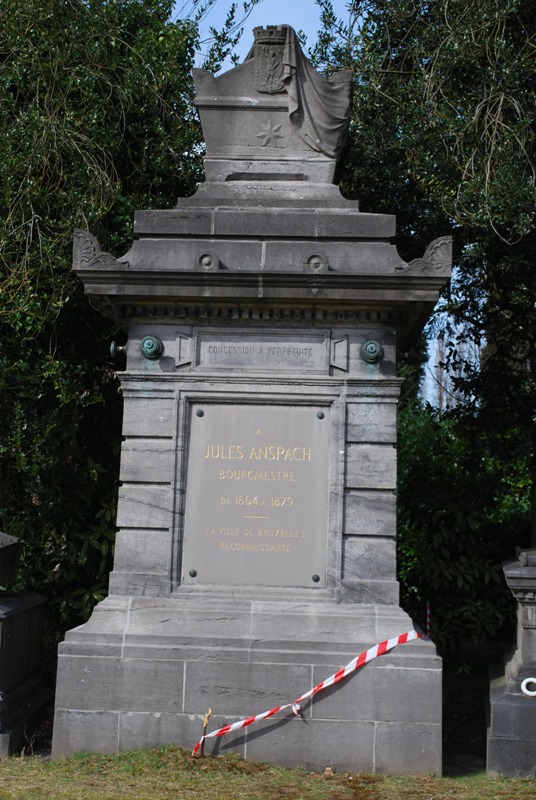Biography ReflexCity.net
After studying at the Royal Athenaeum in Brussels, he studied law at the Université Libre de Bruxelles.
In 1857, he became a liberal municipal councilor in Brussels. On October 15, 1863, Leopold I appointed him burgomaster, replacing André Fontainas, who died unexpectedly. He will keep this post until his death, i.e. for 16 years.
The Bourgmestre builder, an obvious parallel with Leopold II, the King Builder.
We nicknamed Jules Anspach the "Brussels Haussmann" by analogy with the Parisian building Prefect. It should be noted that his office almost coincides with the first part of the reign of Leopold II, the King Builder, who ascended to the throne in 1865.
His desire was to endow Belgium, which was a little over 30 years old, with a capital "worthy" of the name. It is true that, apart from the Royal Quarter dating back to the Austrian period, the center of Brussels was generally in a sorry state.
Its biggest project was the vaulting of the Senne and the construction on the river bed of the 3 large Y-shaped boulevards (Jacqmain, Adolphe Max, Anspach and its straight line extension, Lemonnier) which cross the pentagon from North to South, from Gare du Nord to Gare du Midi (before the opening of the junction). He then launched, under: the impetus of Leopold II, in many other works: the construction of the Stock Exchange, the creation of the Notre-Dame-aux-Neiges district, the extensions of avenue Louise, rue de la Régence and rue Belliard, the Parc du Cinquantenaire. He was still active in many other areas: the development of the distribution of water and gas in homes, the creation of primary schools, etc.
Exhausted by work, he takes a little rest with his brother Eugène who had a country house in Etterbeek: the Linthout pavilion. During a walk in the park, he died there in his fiftieth year on May 19, 1879.
Controversies
Great builders are necessarily also great demolishers. Anspach's work inevitably sparked heated controversy. It is nevertheless interesting to note that a century and a half later, they are still not appeased. Thus, François Schuiten, in the masterpiece of contemporary comic strip "Les Cités obscures" (1990 - 2000), makes Jules Anspach a caricature of absolute ferocity. It is also spicy that if for some authors the former burgomaster is a sort of "lay Saint" adorned with all the virtues, for others he is the accomplice of unscrupulous promoters, throwing the poor out of their homes by the thousands for the greatest profit of the wealthy few.
Without in any way taking sides, the truth forces us to specify that the Senne, a veritable open-air sewer in the middle of the city, was the cause of numerous epidemics. That the center of Brussels was, in 1850, very poor in comparison with other European capitals. And that, finally, the real massacre of an inestimable historical heritage did not really begin until the construction of the North - South Junction (1930) and especially with the major works which prepared the Universal Exhibition of 1958. C t is the start of Brussels, which will irreversibly destroy the city until the end of the 1970s.
See any Map - for anything named after him.∼Belgian politician.Known for his renovations surrounding the covering of the Senne river.
Biography ReflexCity.net
After studying at the Royal Athenaeum in Brussels, he studied law at the Université Libre de Bruxelles.
In 1857, he became a liberal municipal councilor in Brussels. On October 15, 1863, Leopold I appointed him burgomaster, replacing André Fontainas, who died unexpectedly. He will keep this post until his death, i.e. for 16 years.
The Bourgmestre builder, an obvious parallel with Leopold II, the King Builder.
We nicknamed Jules Anspach the "Brussels Haussmann" by analogy with the Parisian building Prefect. It should be noted that his office almost coincides with the first part of the reign of Leopold II, the King Builder, who ascended to the throne in 1865.
His desire was to endow Belgium, which was a little over 30 years old, with a capital "worthy" of the name. It is true that, apart from the Royal Quarter dating back to the Austrian period, the center of Brussels was generally in a sorry state.
Its biggest project was the vaulting of the Senne and the construction on the river bed of the 3 large Y-shaped boulevards (Jacqmain, Adolphe Max, Anspach and its straight line extension, Lemonnier) which cross the pentagon from North to South, from Gare du Nord to Gare du Midi (before the opening of the junction). He then launched, under: the impetus of Leopold II, in many other works: the construction of the Stock Exchange, the creation of the Notre-Dame-aux-Neiges district, the extensions of avenue Louise, rue de la Régence and rue Belliard, the Parc du Cinquantenaire. He was still active in many other areas: the development of the distribution of water and gas in homes, the creation of primary schools, etc.
Exhausted by work, he takes a little rest with his brother Eugène who had a country house in Etterbeek: the Linthout pavilion. During a walk in the park, he died there in his fiftieth year on May 19, 1879.
Controversies
Great builders are necessarily also great demolishers. Anspach's work inevitably sparked heated controversy. It is nevertheless interesting to note that a century and a half later, they are still not appeased. Thus, François Schuiten, in the masterpiece of contemporary comic strip "Les Cités obscures" (1990 - 2000), makes Jules Anspach a caricature of absolute ferocity. It is also spicy that if for some authors the former burgomaster is a sort of "lay Saint" adorned with all the virtues, for others he is the accomplice of unscrupulous promoters, throwing the poor out of their homes by the thousands for the greatest profit of the wealthy few.
Without in any way taking sides, the truth forces us to specify that the Senne, a veritable open-air sewer in the middle of the city, was the cause of numerous epidemics. That the center of Brussels was, in 1850, very poor in comparison with other European capitals. And that, finally, the real massacre of an inestimable historical heritage did not really begin until the construction of the North - South Junction (1930) and especially with the major works which prepared the Universal Exhibition of 1958. C t is the start of Brussels, which will irreversibly destroy the city until the end of the 1970s.
See any Map - for anything named after him.∼Belgian politician.Known for his renovations surrounding the covering of the Senne river.
Family Members
Advertisement
Records on Ancestry
Sponsored by Ancestry
Advertisement










